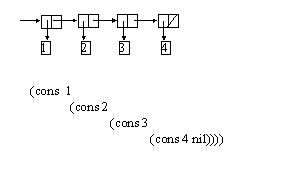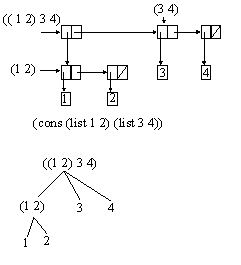4
Building Abstractions with Data
|
What's in This Set of Notes ?
Review (essence of Programming)
-
Computational processes
-
iterative process
-
recursive process
-
Role of procedures in program design
-
Primitive data (numbers)
-
Primitive operations (arithmetic)
-
Combining Procedures to form compound procedures
-
Use of parameters
-
How to abstract procedures with define
-
How to enhance language with higher-order procedures
Focus
Want to build abstractions by combining data objects to form
compound data
Why? (same reasons for compound procedures)
to elevate the conceptual level at which we design programs
increase modularity of design
enhance expressive power of language
Data Abstraction
-
Methodology that enables us to isolate how a compound data
object is used from the details of how it is constructed from more primitive
data objects, enabling one to replace/swap/switch implementations.
Interface between two parts of system (user and developer)
will be a set of procedures called selectors and constructors
Procedural Abstraction
-
Separate the way the procedure would be used from the details
of how the procedure is implemented in terms of more primitive procedures,
enabling one to replace/swap/switch implementations
Example: Rational Numbers
n1/d1 + n2/d2 = (n1d2 + n2d1) / (d1d2)
n1/d1 - n2/d2 = (n1d2 - n2d1) / (d1d2)
n1/d1 * n2/d2 = (n1n2) / (d1d2)
(n1/d1)/ (n2d2) = (n1d2) / (n2d1)
n1/d1 = n2/d2 if and only n1d2 = n2d1
-
Assume you has the following constructors and selectors:
(make-rational ?n ?d) returns a rational number with
numerator ?n and denominator ?d
(numerator ?x) returns numerator of rational number ?x
(denominator ?x) returns denominator of rational number
?x
(define (add-rational x y)
(make-rational (+ (* (numerator x)
(denominator y))
(* (numerator y) (denominator x)))
(* (denominator x) (denominator y))))
(define (subtract-rational x y)
(make-rational (- (* (numerator x)
(denominator y))
(* (numerator y) (denominator x)))
(* (denominator x) (denominator y))))
(define (multiply-rational x y)
(make-rational (* (numerator x) (numerator
y))
(* (denominator x) (denominator y))))
(define (divide-rational x y)
(make-rational (* (numerator x) (denominator
y))
(* (denominator x) (numerator y))))
(define (equal?-rational x y)
(= (* (numerator x) (denominator y))
(* (numerator
y) (denominator x))))
How do we glue together numerator and denominator to represent
rational number?
-
However, notice that we can use rational numbers even though
we don't know anything about how they are structures
-
The answer is Pairs
-
A pair (sometimes called a dotted pair) is a record structure
with two fields called the car and cdr fields (for historical reasons).
-
Pairs are created by the procedure cons.
-
The car and cdr fields are accessed by the procedures car
and cdr.
-
The car and cdr fields are assigned by the procedures set-car!
and set-cdr!
(cons 1 2) => (1.2) // . only for display
(define x (cons 1 2))
(car x) => 1
(cdr x) => 2
(define y ( cons 3 4))
(cons x y) => ((1.2) 3 . 4) //Think of pairs as
a single object
(define z (cons x y))
(car z) => (1.2)
(car (car z)) => 1
(car (cdr z)) => 3
Pair Visualization: Box and Pointer Notation

Closure
-
A package of function and variable bindings is called a closure.
This term derives from the idea that the packaged functions are now "closed"
to the state of the outside world - they can be used in any environment,
independent of the bindings that exist in that environment, because all
of the identifiers they uses are bound either to arguments, local variables,
or the closure's external bindings.
Closure Property
-
an operation (like cons) for combining data objects satisfies
the closure property if the results of combining things with the operation
can themselves be combined using the same operation
Representing rational numbers with Paris
-
(define (make-rational numerator denominator)
-
(cons numerator denominator))
-
(define (numerator rational)
-
(car rational))
-
(define (denominator rational)
-
(cdr rational))
-
Using Rationals
(define one-third (make-rational 1 3))
(add-rational one-third one-third) => (6.9)
Must fix problems with display
-
should not show dot notion
-
should reduce rational to lowest terms
(define (print-rational x)
(newline)
(display (numerator x))
(display "/")
(display (denominator x)))
(print-rational (add-rational one-third one-third)) =>
(6 / 9)
(define (make-rational numerator denominator)
(let (( g (gcd numerator denominator))))
(cons (/ numerator
g) (/ denominator g))))
(print-rational (add-rational one-third one-third)) =>
(1 / 3)
abstraction barriers isolate different
levels of the system
--- (Programs that use rational numbers) ---
rational numbers in problem domain
---- (add-rational , subtract-rational , ...) ---
rational numbers as numerators and denominators
--- (make-rational, numerator, ...) ---
rational numbers as pairs
--- (cons, car, cdr) ---
however paris are implemented
-
--- lines represent abstraction barriers
-
barrier separates the program above that uses the data abstraction
from the program below that implements the data abstraction
-
each level is the interface
-
For data abstraction
-
identify type of data objects
-
identify basic set of operations
-
use only those operations
-
makes programs easier to maintain and modify later
(define (numerator rational)
(let ((g (gcd (car rational) (cdr rational))))
(/ (car rational) g)))
| 4.5
What is Meant by Data |
-
More than just selectors and constructors
-
More than just arbitrary set of procedures
-
Must also specify conditions that these procedures must fulfill
in order to be a valid representation
-
E.G.
If x is (make-rational numerator denominator)
Then
(numerator x)/ (denominator x) = numerator/denominator
-
Same can be said for pairs
If z is (cons x y)
Then
(car z) = x and
(cdr z) = y
-
Therefore, any triple of procedures can provide basis for
pairs
| 4.6
Representing Sequences |
List Structure

-
Instead of cons use list primitive
(list ?a1> ?a2> ... ?an>) which is equivalent
to (cons ?a1> (cons ?a2> ( .... (cons ?an> '()))))
-
Note: #f, nil, and '() are all the same
(define one-to-four (list 1 2 3 4))
(car one-to-four) => 1
(cdr one-to-four) => (2 3 4)
(cons 10 one-to-four) => (10 1 2 3 4)
List Operations
Problem: Find nth element in list?
-
(define (get-element items n)
-
(if (= n 0)
-
(car items)
-
(get-element (cdr
items) (- n 1))))
Technique know as cdring down
-
(define squares (list 1 4 9 16 25))
-
(get-element squares 3) => 16
Problem: Append two lists together?
(define (append list1 list2)
(if (null? list1)
list2
(cons (car
list1)
(append (cdr list1) list2))))
Technique know as consing up
(define odds (list 1 3 5 7 9))
(append square odds) => (1 4 9 16 25 1 3 5 7 9)
Problem: Scaling numbers?
(define (scale-list items factor)
(if (null? items)
nil
(cons (* (car
items) factor)
(scale-list (cdr items) factor))))
Technique know as mapping over lists
(scale-list (list 1 2 3 4 5 ) 10) => ( 10 20 30 40 50)
Abstracting the general idea to capture a common pattern
expressed as a higher-order procedure
(define (map procedure items)
(if (null? items)
nil
(cons (procedure
(car items))
(map procedure (cdr items)))))
(map abs (list -10 2.5 -11.6 17)) => (10 2.5 11.6 17)
(map (lambda (x) (* x x)) (list 1 2 3 4)) => ( 1 4 9
16)
Problem: Selecting numbers?
(define (filter predicate sequence)
(cond ((null? sequence) '())
((predicate (car sequence)) (cons (car sequence) (filter predicate (cdr
sequence))))
(else (filter predicate (cdr sequence)))))
Technique know as filtering over lists
(filter odd? (list 1 2 3 4 5 6 7)) => ( 1 3 5 7)
Problem: Summation of numbers?
(define (accumulate operator initial sequence)
(if (null? sequence)
initial
(operator
(car sequence) (accumulate operator initial (cdr sequence)))))
Technique know as accumulating over lists
(accumulate + 0 (list 1 2 3 4 5)) => 15
(accumulate * 1 (list 1 2 3 4 5)) => 1200
Problem: How to combine mapping and accumulating?
(define (flatten-map procedure sequence)
(accumulate
append nil (map procedure sequence)))
(map list (list 1 2 3)) => ( (1) (2) (3))
(flatten-map list (list 1 2 3)) => ( 1 2 3)
| 4.7
Hierarchical Structures |
-
Lists generalize to represent sequences whose elements may
themselves be sequences (trees)

-
Recursion is a natural tool for dealing with trees
-
(define (count-leaves tree)
-
(cond ((null? tree) 0)
-
((not (pair? tree)) 1)
-
(else ( + (count-leaves (car x))
-
(count-leaves (cdr x))))))
-
Suppose we want (a b)
-
Can't use (list a b) because list will evaluate a b first
-
In order to manipulate symbols we need the ability to quote
a data object
-
Quotation marks indicate that a word or sentences is to be
treated literally as a string of characters
-
Scheme follows the same practice to identify lists and symbols
-
The meaning of single quote character is to quote the
next object
-
Quote also allows us to type in compound objects
(define a 1)
(define b 2)
(list a b) => (1 2)
(list 'a 'b) => (a b)
(list a 'b) => (1 b)
(list 'me 'you) => (me you)
(car '(a b c)) => a
(cdr '(a b c)) => (b c)
-
Violates general rule that all compound expressions should
be delimited by ().
-
Therefore special form quote is added
-
(quote a) and 'a are equivalent, as is (quote ( a b c)) and
'(a b c)


